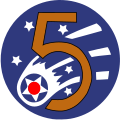8th Flying Training Squadron United States Air Force unit
"8th Tactical Reconnaissance Squadron" redirects here. For the 8th Tactical Reconnaissance Squadron of 1945, see
308th Air Refueling Squadron .
Military unit
The 8th Flying Training Squadron is part of the 71st Flying Training Wing based at Vance Air Force Base , Oklahoma. It operated during World War II and the Korean War , was inactivated in 1951, and reactivated in 1972. It currently conducts flight training using T-6A Texan II aircraft.
Mission
Performs Joint Specialized Undergraduate Pilot Training with T-6A Texan II trainers.
History
World War II
Activated in early 1942 under Fourth Air Force ; after a brief organizational period in Southern California where it was equipped with reconnaissance P-38 Lightnings (F-4) it deployed to the Southwest Pacific Area , being assigned to Fifth Air Force in Australia.
Engaged in long-range tactical reconnaissance missions over New Guinea; later the Netherlands East Indies and in late 1944, over the Philippines in support of MacArthur's Island-Hopping campaign (1942–1945). After the Japanese capitulation in August 1945, became part of the Army of Occupation in Japan. It was not operational between April 1946 and July 1947.
Korean War
From 1947–1949 flew photographic mapping missions over Japan, Korea, Philippines and other areas of western Pacific.[ 5] [ 6] Korean War , the squadron flew tactical reconnaissance sorties over North and South Korea from, 29 June 1950 – 24 February 1951.
Flying training
The 8th has conducted undergraduate pilot training for active duty , Air National Guard , Air Force Reserve and selected foreign allies since 1 November 1972.[ 2] US Navy and US Marine Corps student naval aviators , with command of the squadron alternating between Air Force officers in the rank of lieutenant colonel and Navy officers in the ranks of commander .[ 2] [ 7] [ 8] [ 1]
Lineage
Constituted as the 8th Photographic Squadron on 19 Jan 1942 Activated 1 Feb 1942
Redesignated 8th Photographic Reconnaissance Squadron on 9 Jun 1942
Redesignated 8th Photographic Squadron (Light) on 6 Feb 1943
Redesignated 8th Photographic Reconnaissance Squadron on 13 Nov 1943
Redesignated 8th Tactical Reconnaissance Squadron , Night Photographic on 10 Aug 1948
Redesignated 8th Tactical Reconnaissance Squadron , Photo-Jet on 1 Aug 1949
Inactivated on 25 Feb 1951
Redesignated 8th Flying Training Squadron on 14 Apr 1972
Activated on 1 Nov 1972[ 2]
Assignments
IV Air Support Command , 1 Feb 1942Fifth Air Force , 29 Mar 1942 (attached to Allied Air Forces, Apr – Sep 1942)V Bomber Command , 5 Sep 19426th Photographic Group (later 6th Reconnaissance Group), 13 Nov 1943 (attached to V Bomber Command after c. 10 Dec 1945)V Bomber Command, 27 Apr 1946
314th Composite Wing , 31 May 194671st Reconnaissance Group (later 71st Tactical Reconnaissance Group), 28 Feb 1947 (attached to 314th Composite Wing until Nov 1947)Fifth Air Force, 1 Apr 1949
543d Tactical Support Group , 26 Sep 1950 – 25 Feb 195171st Flying Training Wing , 1 Nov 197271st Operations Group, 15 Dec 1991 – present[ 2]
Stations
Two flights remained at March Field, CA, to 16 Jun 1942 Essendon Airport , Melbourne, Australia, 7 Apr 1942Archerfield Airport (Brisbane) , Australia, 24 Apr 1942Charters Towers Airfield , Australia, 2 May 1942Kila Airfield (3 Mile Drome) , Port Moresby , New Guinea, 9 Sep 1942Nadzab Airfield , New Guinea, 16 Mar 1944Operated from Biak after c. 11 Aug 1944 Air Echelon assigned to Clark Field , Luzon , Philippines, 19 May – 12 Aug 1945 Detachment operated from Itazuke Air Base , Japan, from 29 Jun 1950 Operated from Taegu Air Base (K-2), South Korea, 26 Jan – 25 Feb 1951
Aircraft
Notable members
References
Notes
Explanatory notes
^ Approved 28 July 1990.
^ This emblem was based on the World War II emblem that apparently never received official approval. Maurer, pp. 48-49, cf. Endicott, p. 394.
^ Approved 2 January 1973.
Citations
Bibliography
Endicott, Judy G. (1998). Active Air Force Wings as of 1 October 1995 and USAF Active Flying, Space, and Missile Squadrons as of 1 October 1995 (PDF) . Air Force History and Museums Program. Washington, DC: Office of Air Force History. ASIN B000113MB2 . Retrieved 2 July 2014 . Maurer, Maurer, ed. (1982) [1969]. Combat Squadrons of the Air Force, World War II (PDF) (reprint ed.). Washington, DC: Office of Air Force History. ISBN 0-405-12194-6 LCCN 70605402 . OCLC 72556 . Archived from the original (PDF) on 20 December 2016. Pape, Garry R.; Campbell, John M.; Campbell, Donna (1991). Northrop P-61 Black Widow: The Complete History and Combat Record . Minneapolis, MN: Motorbooks International. ISBN 978-0-879385-09-5 Watkins, Robert A. (2013). Insignia and Aircraft Markings of the U.S. Army Air Force In World War II . Vol. V, Pacific Theater of Operations. Atglen, PA: Shiffer Publishing, Ltd. ISBN 978-0-7643-4346-9 Further reading Stanaway, John and Bob Rocker. The Eight Ballers: Eyes of the Fifth Air Force. The 8th Photo Reconnaissance Squadron in World War II . Atglen, Pennsylvania: Schiffer Publishing, 1999. ISBN 0-7643-0910-2
Leadership Structure
Personnel and Uniforms and History and
Previously: Philippine Department Air Force (1941); Far East Air Force (1941-1942)
Airfields
Units
Commands Wings Groups
Air Commando Bombardment Combat Cargo Fighter Reconnaissance Troop Carrier
Squadrons
Bombardment Night Fighter Reconnaissance Troop Carrier
United States Army Air Forces





















